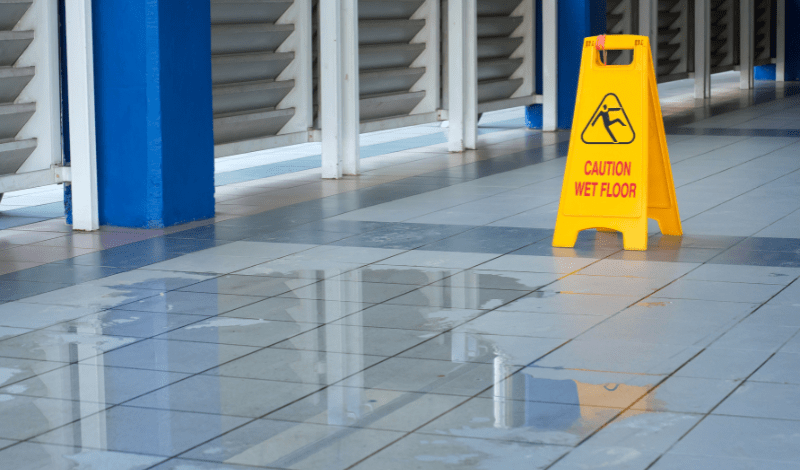
Ensuring workplace safety is a critical concern for businesses across various industries. Custom floor signs are pivotal in this industry, offering a straightforward, effective solution to maintain a secure environment.
This article delves into the importance and implementation of safety floor signs in the workplace. We explore their role in accident prevention, guiding traffic, marking hazards, and reinforcing safety guidelines.
The versatility and impact of these signs in creating a safer workplace are highlighted, emphasizing their necessity in any safety-conscious organization. Join us as we uncover how custom floor signs can transform a regular workspace into a zone of safety and awareness.
What is OSHA’s requirement for safety floor signs?
The United States Occupational Safety and Health Administration (OSHA) mandates workplace floor markings, though it provides limited detailed guidance. Its regulation for walking and working surfaces (29 CFR 1910.22) doesn’t specifically address floor markings.
Instead, it states employers are responsible for ensuring safe access to and from walking-working areas. While OSHA hasn’t set explicit criteria for floor signs, these signs are acknowledged as a crucial element within a comprehensive floor marking strategy.
This includes signs like fire extinguisher floor markers, which, although not explicitly detailed by OSHA, are recognized as essential for workplace safety.
Common types of floor signs
Floor signs, especially custom ones, enhance workplace safety, complementing basic floor marking tapes that outline aisles, pathways, and storage areas.
Here are several key applications:
- Traffic Management: These signs can warn forklift operators to halt, guide traffic flow, and set speed limits.
- Personal Protective Equipment (PPE) Alerts: Custom floor signs can remind employees to don necessary PPE and specify the type required in particular areas.
- Fire Safety Guidance: They play a crucial role in directing employees and visitors to fire exits and locations of fire safety equipment.
- Pedestrian Safety: Custom floor signs are used to delineate pedestrian walkways, highlight pedestrian crossings, and caution workers about the presence of forklifts or other machinery.
In these ways, floor signs custom-tailored to specific workplace needs significantly contribute to a safer and more organized environment.
Where are these safety floor signs commonly used?
Different types of safety signs include:
- Floor Decals: Adhesive stickers placed directly on the floor, often used to mark pathways, hazards, or specific instructions like social distancing.
- Wall Decals: Similar to floor decals but designed for walls, these are used to display safety instructions, emergency exits, and fire equipment locations.
- Hanging Signs: Suspended from ceilings or overhead structures, these signs are visible from a distance and can indicate hazards, directions, or safety reminders.
- A-Frame Signs: Portable, free-standing signs can be placed on floors to indicate temporary hazards like wet floors, ongoing maintenance, or construction areas.
- Stanchion Signs: Mounted on upright poles or stanchions, these are typically used for crowd control or to guide foot traffic in a specific direction.
- Warning Tapes: Adhesive or non-adhesive tapes cordon off hazardous areas or guide traffic flow.
- Projection Signs: These are projected images on floors or walls, offering a modern and versatile way to display safety messages and guides.
Benefits of safety floor signs
Safety floor signs offer several key benefits in a workplace setting:
- Accident Prevention: By clearly marking hazardous areas, indicating safe pathways, and providing essential safety instructions, these signs help reduce the risk of workplace accidents.
- Enhanced Awareness: Floor signs remind employees and visitors about safety practices, keeping safety at everyone’s mind.
- Regulatory Compliance: Many safety floor signs help organizations comply with local, state, and federal safety regulations, including OSHA guidelines.
- Improved Efficiency: Well-placed safety signs can streamline traffic flow and prevent confusion, leading to a more efficient work environment.
- Versatility: Safety floor signs come in various forms, such as decals, markings, and warnings, making them suitable for diverse workplace needs.
- Durability: These signs are often made from sturdy materials that withstand heavy foot traffic and environmental factors, ensuring long-lasting visibility.
- Customization: Floor signs can be customized to address specific hazards or instructions relevant to the workplace, enhancing their effectiveness.
- Emergency Guidance: In emergencies, safety floor signs can guide individuals to exits or emergency equipment, playing a crucial role in evacuation and emergency response.
Conclusion
Safety floor signs are essential for a safe, efficient workplace. They effectively prevent accidents, enhance safety awareness, and ensure regulatory compliance. They offer versatile, durable solutions for various workplace needs, from decals to projection signs.
By integrating these signs, businesses foster a safety-conscious environment, protecting employees and visitors. Safety floor signs are invaluable in maintaining a secure and informed workplace.

